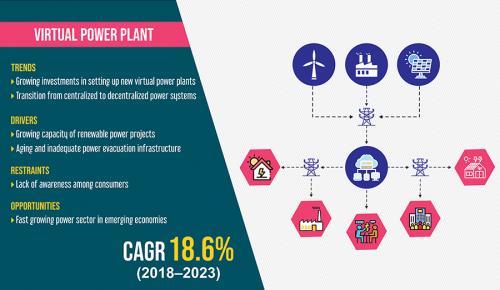How are Virtual Power Plants Helping Save Environment?

With the demand for electricity rising at an exponential rate, 4.0% in 2018 as per the International Energy Agency (IEA), the requirement for fuels to generate this power is also increasing. The increased burning of fossil fuels, such as coal and crude oil, which are still the major sources of electricity generation, pushed the carbon emissions up by 2.5% that year, the IEA reported. As the electricity demand and carbon emissions continue to rise owing to rapid industrialization and urbanization, the need to save the environment is becoming more dire than ever. This has given birth to the novel concept of virtual power plants (VPP), which refers to an inter-connected network of power plants, not connected to the government grid, and power consumers. The power plants are generally small solar or wind farms with a maximum capacity of 10 MW. Such a model automatically distributes power across small distances, depending on the demand.
P&S Intelligence said in a study that the worldwide virtual power plant market valued $1,975.1 million in 2017 and that it would grow rapidly at an 18.6% CAGR to ultimately reach $5,510.2 million. Supply side, demand response and mixed assets are the three technologies on which VPPs work. Among these, demand response VPPs supplied the most amount of electricity in 2017 as they are preferred by consumers. Such power plants offer several incentives to consumers, such as lower tariff, to encourage them to reduce their electricity consumption during periods of peak demand. This ensures that as many consumers who need electricity can get it, and the demand–supply gap doesn’t worsen. This is why such power plants will continue being the largest distributor of electricity among all VPPs in the years to come.
With the rising need for electricity and saving the environment at the same time, the investments in VPPs are also increasing. Another reason for the rising popularity of such power generation facilities is the huge capital involved in constructing and maintaining conventional power stations. Commercially viable VPPs have already been constructed or are under construction in the U.S., Germany, and China. Now, with increasing funding, the size and power generation capacities of such facilities are also increasing. For instance, energy giant, Tesla, is constructing a 250 MW virtual power plant in Adelaide, Australia at a cost of $250.0 million, which is expected to start distributing electricity to 50,000 houses in 2022.
Another factor helping VPPs become more popular is the growing capacities of renewable power stations. It is being predicted that compared to 7.0% in 2015, almost 20.0% of the total power generated in 2035 will be from renewable sources. Countries such as India and China are strongly pursuing their goal of generating as much electricity as possible from clean sources. For instance, India has plans to have 150 GW of renewable energy installed capacity by 2022-end, whereas China aims to generate almost 200 GW of power from solar farms alone by 2020. It is owing to government initiatives such as these that among all regions, the virtual power plant market would grow the fastest in Asia-Pacific in the near future, outpacing even North America, which is currently the most lucrative region for VPP firms.
Post Your Ad Here
Comments